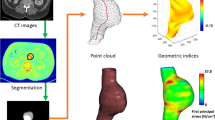Abstract
Abdominal aortic aneurysm (AAA) is a local, progressive dilation of the distal aorta that risks rupture until treated. Using the law of Laplace, in vivo assessment of AAA surface geometry could identify regions of high wall tensions as well as provide critical dimensional and shape data for customized endoluminal stent grafts. In this study, six patients with AAA underwent spiral computed tomography imaging and the inner wall of each AAA was identified, digitized, and reconstructed. A biquadric surface patch technique was used to compute the local principal curvatures, which required no assumptions regarding axisymmetry or other shape characteristics of the AAA surface. The spatial distribution of AAA principal curvatures demonstrated substantial axial asymmetry, and included adjacent elliptical and hyperbolic regions. To determine how much the curvature spatial distributions were dependent on tortuosity versus bulging, the effects of AAA tortuosity were removed from the three-dimensional (3D) reconstructions by aligning the centroids of each digitized contour to the z axis. The spatial distribution of principal curvatures of the modified 3D reconstructions were found to be largely axisymmetric, suggesting that much of the surface geometric asymmetry is due to AAA bending. On average, AAA surface area increased by 56% and abdominal aortic length increased by 27% over those for the normal aorta. Our results indicate that AAA surface geometry is highly complex and cannot be simulated by simple axisymmetric models, and suggests an equally complex wall stress distribution. © 1999 Biomedical Engineering Society.
PAC99: 8719Rr, 8759Fm, 8757Gg
Similar content being viewed by others
REFERENCES
Ahn, S., D. Eton, and K. Hodgson. Current concepts in endovascular surgery. In: Medical Intelligence Unit. Austin: R. G. Landes, 1994, p. 128.
Darling, R., C. Messina, D. Brewster, and L. Ottinger. Autopsy study of unoperated abdominal aortic aneurysms. J. Vasc. Surg. 56:161–164, 1977.
Dobrin, P. Pathophysiology and pathogenesis of aortic aneurysms. Surg. Clin. North Am. 69:687–703, 1989.
Elger, D. F., D. M. Blackketter, R. S. Budwig, and K. H. Johansen. The influence of shape on the stresses in model abdominal aortic aneurysms. J. Biomech. Eng. 118:326–332, 1996.
Flugge, W. Tensor Analysis and Continuum Mechanics. New York: Springer-Verlag, 1972, p. 207.
Hollier, L., L. Taylor, and J. Ochsner. Recommended indication for operative treatment of abdominal aortic aneurysms. J. Vasc. Surg. 15:1046–1056, 1992.
Inzoli, F., F. Boschetti, M. Zappa, T. Longo, and R. Fumero. Biomechanical factors in abdominal aortic aneurysm rupture. Eur. J. Vasc. Surg. 7:667–674, 1993.
Mower, W., L. Baraff, and J. Sneyd. Stress distributions in vascular aneurysms: Factors affecting risk of aneurysm rupture. J. Surg. Res. 55:155–161, 1993.
Parodi, J., F. Criado, H. Barone, C. Schonholz, and L. Queral. Endoluminal aortic aneurysm repair using a balloonexpandable stent-graft device: A progress report. Ann. Vas. Surg. 8:523–529, 1994.
Sacks, M. S., C. J. Chuong, G. H. Templeton, and R. Peshock. In vivo 3D reconstruction and geometric characterization of the right ventricular free wall. Ann. Biomed. Eng. 21:263–275, 1993.
Smith, D., M. Sacks, P. Pattany, and R. Schroeder. Fatigue induced changes in bioprosthestic heart valve 3D geometry and the relation to tissue damage. J. Heart Valve Dis. 8:25–33, 1999.
Smith, D., M. Sacks, M. Raghavan, M. Federle, M. Webster, and D. Vorp. A biquintic hermite finite element for surface geometric analysis of abdominal aortic aneurysms. In: Third World Congress on Biomechanics, Hokaiddo, Japan, 1998.
Smith, D. B., M. S. Sacks, P. M. Pattany, and R. Schroeder. High-resolution magnetic resonance imaging to characterize the geometry of fatigued porcine bioprosthetic heart valves. J. Heart Valve Dis. 6:424–432, 1997.
Stringfellow, M., P. Lawrence, and R. Stringfellow. The influence of aorta-aneurysm geometry upon stress in the aneurysm wall. J. Surg. Res. 42:425–433, 1987.
Struik, D. J. Lectures on Classical Differential Geometry, 2nd ed. New York: Dover, 1961, p. 232.
Vorp, D., M. Raghavan, and M. Webster. Mechanical wall stress in abdominal aortic aneurysm: Influence of diameter and asymmetry. J. Vasc. Surg. 27:632–639, 1998.
Wolf, Y. G., and E. F. Bernstein. A current perspective on the natural history of abdominal aortic aneurysms. Cardiovasc. Surg. 2:16–22, 1994.
Author information
Authors and Affiliations
Rights and permissions
About this article
Cite this article
Sacks, M.S., Vorp, D.A., Raghavan, M.L. et al. In Vivo Three-Dimensional Surface Geometry of Abdominal Aortic Aneurysms. Annals of Biomedical Engineering 27, 469–479 (1999). https://doi.org/10.1114/1.202
Issue Date:
DOI: https://doi.org/10.1114/1.202




